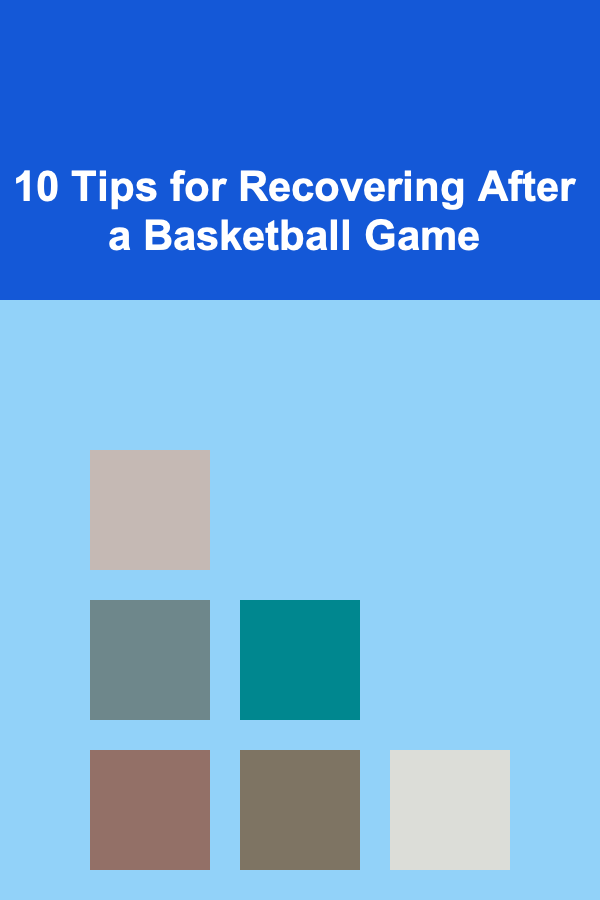
10 Tips for Recovering After a Basketball Game
ebook include PDF & Audio bundle (Micro Guide)
$12.99$6.99
Limited Time Offer! Order within the next:

Basketball is an intense sport that demands both physical and mental energy. After playing a game, whether it's a casual pickup game or a competitive match, proper recovery is essential to maintain your performance and avoid injury. Recovery helps to replenish energy, reduce muscle soreness, and prevent long-term damage. This article offers ten crucial tips that can help you recover effectively after a basketball game, so you're ready to get back on the court as soon as possible.
Hydrate Properly
One of the most important recovery steps after a basketball game is rehydration. Basketball is a high-intensity sport that makes players sweat a lot, leading to a loss of fluids and electrolytes. If you don't rehydrate properly, you risk dehydration, muscle cramps, and fatigue, which can negatively affect your future performance.
How to Hydrate:
- Water: Start by drinking water immediately after the game to restore the fluids you lost during play.
- Electrolyte Drinks: Consider drinking sports drinks or electrolyte-rich beverages to replenish sodium, potassium, and other minerals lost in sweat.
- Avoid Caffeine and Alcohol: These substances can dehydrate your body, so avoid them post-game to maximize your recovery.
Tip: Aim to drink at least 16-24 ounces of fluids for every pound of body weight lost during the game.
Refuel with the Right Nutrition
Post-game nutrition is key to replenishing the energy used during the game and aiding muscle recovery. After intense physical activity, your body needs carbohydrates to replenish glycogen stores, proteins to repair muscle fibers, and healthy fats to support overall recovery.
Recommended Post-Game Meal:
- Carbohydrates: Whole grains, fruits, and vegetables to replenish glycogen.
- Protein: Lean meats, fish, eggs, or plant-based protein sources to promote muscle repair.
- Fats: Healthy fats from nuts, seeds, avocado, or olive oil to support recovery.
- Vitamins and Minerals: Include a variety of colorful vegetables to provide the micronutrients necessary for repair and recovery.
Tip: A balanced post-game meal should ideally be consumed within 30 to 60 minutes after the game for optimal recovery.
Stretch and Cool Down
Stretching is crucial for recovery after physical activity, especially for athletes who have just played a high-impact sport like basketball. Stretching helps to increase blood flow to the muscles, reduce muscle tension, and improve flexibility, which aids in the recovery process.
Effective Stretching Exercises:
- Hamstring Stretch: A great way to relieve tightness in the legs.
- Quad Stretch: To stretch the front of the thighs, which are heavily used during running and jumping.
- Calf Stretch: After all the jumping and sprinting, this will help your calves recover.
- Hip Flexor Stretch: This helps reduce tightness in the hips, which are often overworked during the game.
Tip: Hold each stretch for 20-30 seconds and repeat 2-3 times for optimal results.
Foam Rolling for Myofascial Release
Foam rolling, or self-myofascial release, is a technique that helps to relieve muscle tightness and improve circulation. After a basketball game, foam rolling can help target specific muscle groups, reducing muscle soreness and improving the range of motion.
Focus Areas for Foam Rolling:
- Quadriceps: Often tight after running and jumping.
- Hamstrings: Helps relieve tension in the back of the legs.
- Glutes: Can become tight after lots of explosive movements.
- Calves and IT Band: Key areas to release tension from repetitive motions.
Tip: Roll slowly and spend extra time on areas that feel particularly tight or sore. Use a foam roller for about 10-15 minutes post-game.
Get Quality Sleep
Sleep is one of the most powerful recovery tools available. During sleep, your body repairs damaged tissues, reduces inflammation, and restores energy. Lack of sleep can result in increased fatigue, poor performance, and slower recovery. To recover properly, ensure you get enough restful sleep.
Tips for Quality Sleep:
- Aim for 7-9 hours of sleep per night.
- Create a Relaxing Sleep Environment: Keep your room cool, dark, and quiet.
- Avoid Screens: Stay away from electronics like phones, tablets, and computers at least 30 minutes before bed.
- Stick to a Sleep Schedule: Try to go to bed and wake up at the same time each day, even on weekends.
Tip: Consider a post-game relaxation routine, such as meditation or reading, to help your body unwind and prepare for sleep.
Ice and Heat Therapy
Ice and heat therapy are both effective methods for reducing inflammation, relieving pain, and speeding up recovery after a basketball game. Ice therapy, often called cryotherapy, helps reduce swelling and muscle inflammation, while heat therapy increases blood flow and aids in muscle relaxation.
How to Use Ice and Heat:
- Ice Therapy: Apply an ice pack to areas of soreness or swelling for 15-20 minutes. Ice is particularly useful for injuries, such as sprains or strains.
- Heat Therapy: Use a warm towel or heating pad to relax tight muscles. Apply heat for 15-20 minutes after the first 24-48 hours of an injury when swelling has reduced.
Tip: Alternate between ice and heat if you're dealing with both soreness and tightness.
Take an Epsom Salt Bath
An Epsom salt bath is a great way to soothe sore muscles and promote relaxation. Epsom salt contains magnesium, which is absorbed through the skin and has anti-inflammatory properties that help muscles recover more efficiently.
How to Take an Epsom Salt Bath:
- Add 2 cups of Epsom salt to a warm bath.
- Soak for 20-30 minutes, allowing the magnesium to be absorbed.
- Use this as a relaxation tool after your stretches and foam rolling.
Tip: Taking an Epsom salt bath before bed can also help you relax and get a better night's sleep.
Active Recovery
While resting is important, some light movement can actually aid in your recovery. Active recovery involves low-intensity exercise that gets your blood flowing without overloading your muscles. This helps prevent stiffness and improves muscle elasticity.
Active Recovery Options:
- Light Jogging or Walking: A slow-paced jog or walk can help loosen up your legs and promote circulation.
- Swimming: The buoyancy of water makes swimming an excellent low-impact recovery activity.
- Cycling: Light cycling is another great option for gently stretching and activating muscles.
Tip: Keep the intensity low---aim for about 30 minutes of active recovery a day after a game.
Avoid Overtraining
While it's essential to stay active and keep your body in good condition, overtraining can actually hinder recovery and increase the risk of injury. Make sure you balance your intense basketball sessions with rest and low-intensity recovery activities.
Signs of Overtraining:
- Persistent soreness or fatigue.
- Decreased performance or lack of motivation.
- Increased injuries or strains.
- Difficulty sleeping or resting.
Tip: Listen to your body and take rest days when necessary. Overtraining can lead to burnout, so ensure you allow sufficient time for recovery between intense basketball games.
Consult a Sports Specialist
If you experience any injuries or persistent discomfort after a basketball game, it's essential to consult with a sports specialist, such as a physical therapist or chiropractor. These professionals can help assess your injury, provide targeted treatments, and offer exercises to aid in your recovery.
When to See a Sports Specialist:
- If you experience sharp pain, swelling, or bruising.
- If soreness persists for more than a few days.
- If you have concerns about your recovery or injuries.
Tip: Early intervention can prevent long-term damage and ensure you recover properly before getting back on the court.
Conclusion
Recovering after a basketball game is just as important as your performance during the game itself. Proper recovery strategies such as hydration, nutrition, stretching, rest, and active recovery can help you minimize soreness, prevent injuries, and get back to playing at your best. By following these 10 tips, you can improve your recovery time and continue to perform at a high level throughout the basketball season. Remember, consistency in recovery is key to maintaining both your health and your game.
Reading More From Our Other Websites
- [Home Rental Property 101] How to Handle Disputes with Tenants Professionally
- [Personal Care Tips 101] How to Apply Brow Gel for Natural-Looking Eyebrows
- [Mindful Eating Tip 101] Stress-Free Meals: Mindful Eating Techniques for Reducing Inflammation and IBS
- [Home Pet Care 101] The Importance of Regular Vet Check-ups for Your Pet
- [Gardening 101] Seasonal Scheduling: When to Plant, Harvest, and Rotate Your Vegetables
- [Home Budget 101] How to Build an Emergency Fund Savings That Actually Works
- [Home Security 101] How to Use Motion Sensor Lights for Enhanced Security
- [Scrapbooking Tip 101] How to Create Themed Scrapbooks for Wedding Anniversaries and Milestones
- [Organization Tip 101] How to Include a Recycling Station in Your Garage
- [Screen Printing Tip 101] Troubleshooting Common Issues in Fabric Screen Printing: Tips from the Pros

How to Budget for Special Occasions and Events
Read More
How to Declutter Your Garage for a Fresh Start
Read More
How to Maximize Closet Space with Adjustable Shelving
Read More
Top Thrifty Clothing Shopping Strategies to Save Money Without Sacrificing Style
Read More
Neuromarketing: Unlocking the Consumer Brain for Better Results
Read More
Creating a System for Managing Digital Clutter
Read MoreOther Products

How to Budget for Special Occasions and Events
Read More
How to Declutter Your Garage for a Fresh Start
Read More
How to Maximize Closet Space with Adjustable Shelving
Read More
Top Thrifty Clothing Shopping Strategies to Save Money Without Sacrificing Style
Read More
Neuromarketing: Unlocking the Consumer Brain for Better Results
Read More